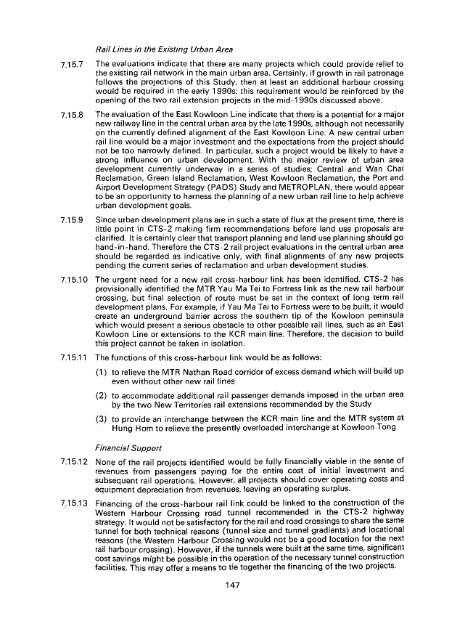Untitled - HKU Libraries - The University of Hong Kong
Untitled - HKU Libraries - The University of Hong Kong
Untitled - HKU Libraries - The University of Hong Kong
- No tags were found...
Create successful ePaper yourself
Turn your PDF publications into a flip-book with our unique Google optimized e-Paper software.
Rail Lines in the Existing Urban Area7.15.7 <strong>The</strong> evaluations indicate that there are many projects which could provide relief tothe'existing rail network in the main urban area. Certainly, if growth in rail patronagefollows the projections <strong>of</strong> this Study, then at least an additional harbour crossingwould be required in the early 1990s; this requirement would be reinforced by theopening <strong>of</strong> the two rail extension projects in the mid-1990s discussed above.7.1 5.8 <strong>The</strong> evaluation <strong>of</strong> the East Kowioon Line indicate that there is a potential for a majornew railway line in the central urban area by the late 1990s f although not necessarilyon the currently defined alignment <strong>of</strong> the East Kowloon Line. A new central urbanrail line would be a major investment and the expectations from the project shouldnot be too narrowly defined, in particular, such a project would be likely to have astrong influence on urban development. With the major review <strong>of</strong> urban areadevelopment currently underway in a series <strong>of</strong> studies; Central and Wan ChaiReclamation, Green Island Reclamation, West Kowloon Reclamation, the Port andAirport Development Strategy (PADS) Study and METRO PLAN, there would appearto be an opportunity to harness the planning <strong>of</strong> a new urban rail line to help achieveurban development goals.7.15.9 Since urban development plans are in such a state <strong>of</strong> flux at the present time, there islittle point in CTS-2 making firm recommendations before land use proposals areclarified. It is certainly clear that transport planning and land use planning should gohand-in-hand. <strong>The</strong>refore the CTS-2 rail project evaluations in the central urban areashould be regarded as indicative only, with final alignments <strong>of</strong> any new projectspending the current series <strong>of</strong> reclamation and urban development studies.7.15.10 <strong>The</strong> urgent need for a new rail cross-harbour link has been identified. CTS-2 hasprovisionally identified the MTR Yau Ma Tes to Fortress link as the new rail harbourcrossing, but final selection <strong>of</strong> route must be set in the context <strong>of</strong> long term raildevelopment plans. For example, if Yau Ma Tei to Fortress were to be built, it wouldcreate an underground barrier across the southern tip <strong>of</strong> the Kowloon peninsulawhich would present a serious obstacle to other possible rail lines, such as an EastKowloon Line or extensions to the KCR main line. <strong>The</strong>refore, the decision to buildthis project cannot be taken in isolation.7.15.11 <strong>The</strong> functions <strong>of</strong> this cross-harbour link would be as follows:(1) to relieve the MTR Nathan Road corridor <strong>of</strong> excess demand which will build upeven without other new rail lines(2) to accommodate additional rail passenger demands imposed in the urban areaby the two New Territories rail extensions recommended by the Study(3) to provide an interchange between the KCR main line and the MTR system atHung Horn to relieve the presently overloaded interchange .at Kowloon TongFinancial Support7.15.12 None <strong>of</strong> the rail projects identified would be fully financially viable in the sense <strong>of</strong>revenues from passengers paying for the entire cost <strong>of</strong> initial investment andsubsequent rail operations- However, all projects should cover operating costs andequipment depreciation from revenues, leaving an operating surplus.7.15.13 Financing <strong>of</strong> the cross-harbour rail link could be linked to the construction <strong>of</strong> theWestern Harbour Crossing road tunnel recommended in the CTS-2 highwaystrategy. It would not be satisfactory for the rail and road crossings to share the sametunnel for both technical reasons (tunnel size and tunnel gradients) and locatsonalreasons (the Western Harbour Crossing would not be a good location for the nextrail harbour crossing). However, if the tunnels were built at the same time, significantcost savings might be possible in the operation <strong>of</strong> the necessary tunnel constructionfacilities. This may <strong>of</strong>fer a means to tie together the financing <strong>of</strong> the two projects.147
















